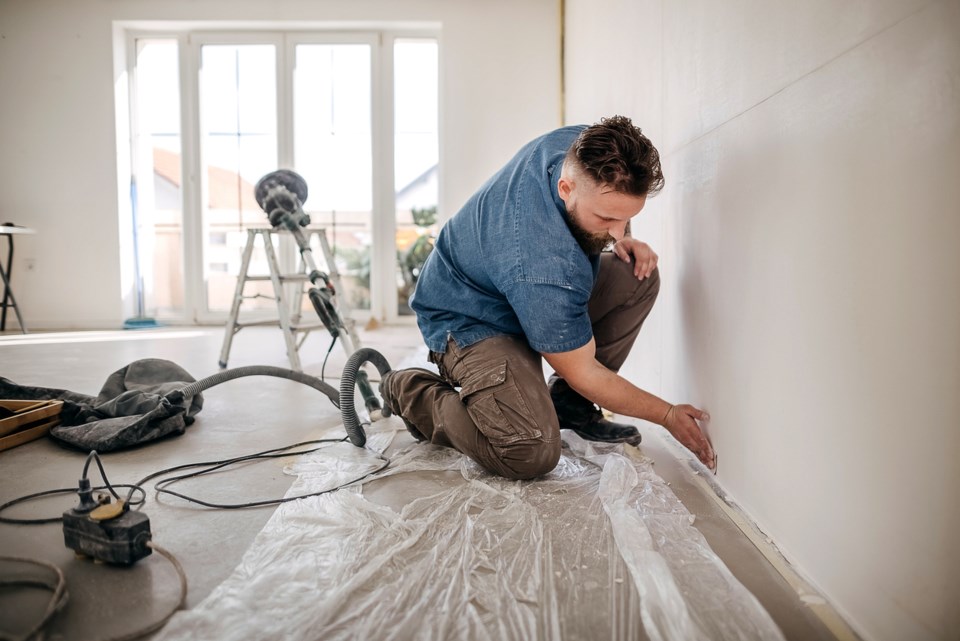As we firmly transition into fall, inside home improvement projects rather than gardening and yard work gets pushed up those to-do lists before the snow hits.
When it comes to drywall installations, there are seven different types of drywall to choose from, and each type is suitable for different kinds of installations. So, if you’re planning a renovation, an extension, or just want to conduct general care and repair on your home, it’s essential to understand which type of drywall will suit your project best.
What is drywall?
Drywall replaced labor-intensive plaster work decades ago because it's faster to install, easier to patch, and less expensive. Invented in 1916, drywall caught on in the construction world around 25 years later.
Drywall is mostly made of the mineral gypsum, with additives and an emulsifier, which is blended with water and then mixed into a paste. The paste is spread between Manila paper, and the resulting sheets are heated to dry them out and prepare them for cutting into the final boards.
Drywall also has other names, including gyp board, wallboard, plasterboard, sheetrock, or gypsum board. Different types of drywall are made using additional additives or types of paper.
Before you go out and buy drywall for your home improvement project, consider which drywall type is best from paper, paperless, blue, green, white, Type X, and noise-proof.
White board (regular drywall)
White board is usually white on one side and brown on the other; it’s the most commonly used, often the cheapest, and you can find it in most building supply stores. White board is suitable for most rooms, but it has no special mold or mildew-resistant properties, so it is usually used in bedrooms, living rooms, hallways, and basements.
Best for: Walls and ceilings in general-purpose rooms.
Green board drywall
This moisture-resistant drywall is green, and its wax cover repels more moisture than regular drywall. That said, it isn’t waterproof, so it’s not suitable for direct contact with water. Still, it is often used behind tiles in rooms with minimal wetness, like basements, bathrooms, kitchens, laundry, and utility rooms. As well, green board drywall is more expensive than regular drywall.
Best for: Rooms with more moisture, like bathrooms, kitchens, laundry rooms, basements, and utility rooms.
Blue board drywall
Sometimes called plaster baseboard, blue board drywall is used as a backing for veneer plastering, which is added on top. The surface paper of blue board has absorption qualities for the veneer and will look like plaster when it's finished. Blue board drywall isn’t made to be used with mud, tape, or paint. However, it has high water and mold resistance, making it better for bathrooms, and it also has noise-proofing qualities. Blue board drywall will usually set you back about the same amount as green board drywall.
Best for: Plaster backing in bathrooms and rooms with more moisture.
Paperless drywall
This type of drywall is covered in fiberglass, not paper, which gives it better resistance to mildew and mold, and it protects the gypsum board from blight. Paperless drywall is becoming more common, but it's also a bit tougher. You may need extra joint compound to create a smooth surface. As well, some find paperless drywall is easier to cut. The qualities of paperless drywall do mean that it will be more expensive than regular drywall.
Best for: Durability and water/rot resistance.
Purple drywall
Purple drywall has similar properties to green drywall and much the same applications. However, it does have better mold and mildew resistance. Its gypsum is coated with 100% recycled paper. It can be used for any walls or ceiling but is great for areas where you might need moisture and mold resistance. Purple drywall can run more expensive, and it does come in high-impact and noise-proofing versions.
Best for: Areas prone to mold and moisture.
Type X drywall
Type X drywall is the more fire-resistant option. It has fiberglass in the gypsum core and can be installed in several layers, which is said to slow the progression of a fire. This thickness also makes type X drywall suitable for noise-proofing. However, it is more difficult to cut and will be more expensive than regular drywall.
Best for: Fire resistance, garages, and apartment buildings that require Type X to meet code/regulations.
Soundproof drywall
Need a quieter space? Soundproof drywall might be the option you are looking for; it’s a laminated drywall made with gypsum, wood fibers, and polymers. It’s thicker, so it will be more difficult to cut, and it is more expensive than some of the other drywall options.
Best for: Keeping noise in or out.
That’s your round-up of types of drywall and their applications, courtesy of Bernardi Building Supply in Toronto who have experts on hand to answer any of your drywall and other home improvement questions.
When choosing drywall for your renovations and improvements, consider the needs of the room or area. Do you need drywall to meet building codes or regulations? Are you installing drywall in a room that can be humid, or could it be exposed to water or at higher risk of mold, mildew, or rot?
Choosing the right drywall will help you achieve a beautiful project finish that lasts.
For more guidance on your drywall installation, contact Bernardi Building Supply and get connected to one of their experts to answer any of your drywall and other home improvement questions.
